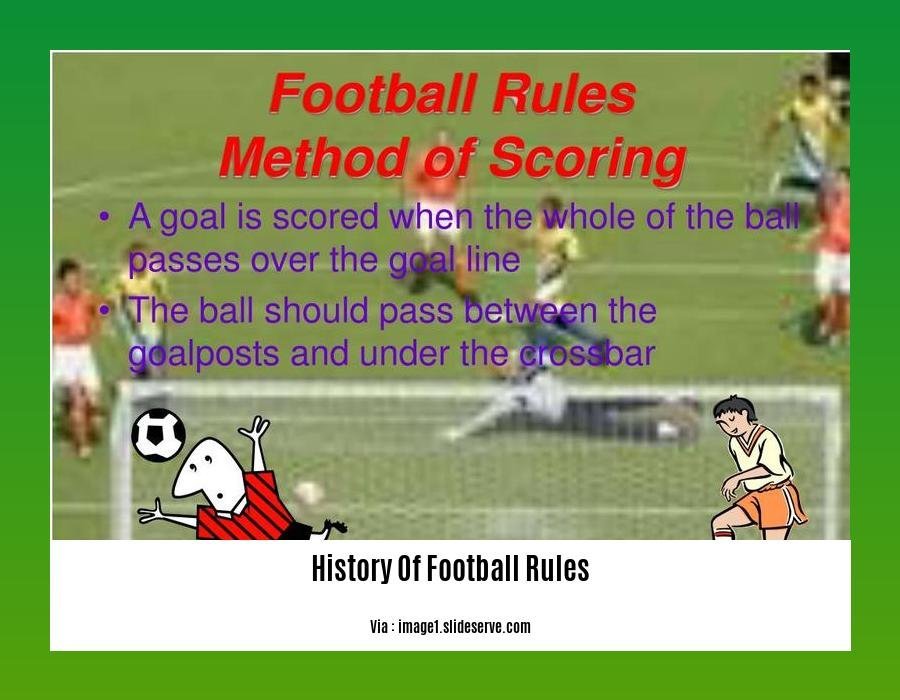Delve into the fascinating history of football rules as we embark on a journey through the evolution of the beautiful game, uncovering the intriguing stories and pivotal moments that have shaped the sport we know and love today: [Unveiling the History of Football Rules: A Journey Through the Evolution of the Beautiful Game].
Key Takeaways:
Offside rules have undergone changes, originally requiring passes to be made sideways or backwards.
Referees were introduced in 1871 to maintain order on the field, replacing team captains’ previous responsibilities.
Penalties replaced indirect free kicks as the closest equivalent in 1891.
The goalkeeper position became distinct in 1909 when the last player wore a different colored shirt.
Corner-kicks were introduced in 1872, and in 1924, it was ruled that a corner-kick could be scored directly.
History of Football Rules

Football, with its billions of fans worldwide, didn’t just become the beautiful game overnight. Its rules have evolved over the years, reflecting the sport’s ever-changing tactics and strategies. Join us as we journey through the annals of football, tracing the evolution of the laws that shape this beautiful game.
The Early Kick-Off
The 1863 Football Association (FA) rules marked the beginning of codifying the game. These early rules established the basics, including the number of players, field dimensions, and fouls. The offside rule, initially requiring passes to be made sideways or backward, aimed to prevent “cherry-picking” goals.
The Dawn of Order
In 1871, football took a significant step forward with the introduction of referees. They replaced team captains in maintaining order on the field, ensuring impartial officiating. This marked a crucial moment in establishing the authority figure in the game.
Penalties: A New Era of Justice
1891 saw the emergence of penalties. They replaced indirect free kicks, becoming the ultimate punishment for fouls inside the penalty area. This rule change emphasized the importance of fair play and upholding the integrity of the game.
The Goalkeeper’s Distinction
In 1909, the goalkeeper position gained its distinctive identity. The last man in defense donned a different colored shirt, symbolizing their unique role in protecting the goal. This visual cue enhanced the clarity and understanding of the game for players and spectators alike.
Corner Kicks: Scoring from the Corner
Corner kicks were introduced in 1872, providing a strategic opportunity to score from the corner of the field. In 1924, the rules were amended, allowing for direct corner-kick goals. This opened up new avenues for teams to devise innovative attacking strategies.
Want to know more about how far back does first aid date? Take a look at the history of first aid to learn about the fascinating evolution of this life-saving practice.
Did you know fountains have a rich and varied history? Explore the history of fountains and discover the captivating stories behind these iconic water features.
Curious about the origins and development of Hindustani classical music? Dive into the history of Hindustani classical music and uncover the fascinating journey of this enchanting musical tradition.
Evolution of Football Rules Through the Years

In the ever-evolving world of football, the rules have undergone a rich journey, shaping the game into the thrilling spectacle we know today. From the humble beginnings of the sport in the 19th century to the modern era’s intricate regulations governing every aspect of the game, it’s safe to say that the beautiful game has seen its fair share of adjustments and refinements. Let’s dive into the fascinating history and evolution of football rules!
The Early Days:
In the early days of football, the rules were much simpler, with the main focus on physicality and teamwork. Player positions were fluid, and offside rules hadn’t yet come into play.
The game was primarily played at schools and universities, with each institution having its own set of rules. This led to a lack of uniformity, which hindered the widespread popularity of the sport.
1863: The Dawn of Codification
The year 1863 marked a pivotal moment in the history of football when the Football Association (FA) was formed in England. The association introduced standardized rules, creating a uniform framework for the game across the country.
The FA’s rules included key elements like player count, field dimensions, fouls, and the introduction of the offside rule. These rules aimed to create a more organized, fair, and enjoyable game for all.
1871: The Birth of the Referee
In the early days, the captains of each team were responsible for maintaining order and resolving disputes on the field. This system often led to arguments and inconsistencies.
The year 1871 saw the introduction of referees to officiate matches. The FA appointed two referees to take charge of games, ensuring impartial and consistent enforcement of the rules. This marked a significant step toward improving the fairness and integrity of the sport.
1891: Penalty Kicks Make Their Debut
Prior to 1891, fouls committed within the penalty area were treated as indirect free kicks. This meant that a goal could not be scored directly from a penalty kick.
In 1891, the penalty kick was introduced as a way to punish fouls inside the penalty area more severely. This rule change transformed the game, adding an exciting new dimension to the sport and increasing the likelihood of goals being scored.
1909: The Goalkeeper Takes Center Stage
The goalkeeper’s role was initially not distinct from other players, and they were expected to participate in the general play. However, in 1909, a new rule stated that the last player on a team must wear a different colored shirt to distinguish themselves.
This rule change highlighted the specialized role of the goalkeeper and emphasized the need for a dedicated player to protect the goal. It also improved communication and clarity on the field for both players and spectators.
1924: Corner Kicks Gain Momentum
Corner kicks were introduced in 1872 to restart the game after the ball went out of bounds over the end line. Initially, corner kicks could not be scored directly, and the ball had to be passed before a goal could be scored.
In 1924, the rules were amended to allow goals to be scored directly from corner kicks if the ball entered the goal directly without touching another player. This change opened up new tactical possibilities and made corner kicks a more dangerous attacking weapon.
Key Takeaways:
– The evolution of football rules has been a continuous process, shaped by the desire to create a fair, organized, and enjoyable game for all.
– The introduction of standardized rules in 1863 laid the foundation for the modern game, with the FA establishing key elements like player count, field dimensions, and the offside rule.
– The addition of referees in 1871 ensured impartial officiating and improved the fairness and integrity of matches.
– The introduction of the penalty kick in 1891 and the recognition of the goalkeeper’s unique role in 1909 further refined the game’s dynamics.
– The 1924 rule change allowing direct goals from corner kicks opened up new attacking possibilities and added excitement to the game.
Sources:
– The History of Football Rules
– The Evolution of Football Rules
Key Milestones in the History of Football Regulations
As football’s popularity skyrocketed, governing bodies stepped in to bring order to the chaos of the beautiful game. Let’s dive into the evolution of football rules, a journey marked by milestones that shaped the sport into what it is today.
1. 1848: The Cambridge Rules: A Foundation Laid
In the heart of Cambridge University, football enthusiasts gathered to create a set of rules that would unify the game’s chaotic nature. The Cambridge Rules emerged, establishing a standardized framework for player count, field dimensions, and basic rules for fouls. These principles laid the groundwork for the modern game of football.
2. 1863: The Football Association (FA): Uniting the Game
England witnessed the birth of an organization destined to shape the future of football – the Football Association (FA). This pivotal moment marked the beginning of codified and standardized rules. The FA’s regulations covered various aspects, including the number of players, field dimensions, and the introduction of the offside rule.
3. 1891: Penalties: Upholding Fair Play
In a bid to curb reckless play and promote fair competition, the FA introduced the penalty kick. This game-changing rule replaced indirect free kicks within the penalty area with a spot kick. The introduction of penalties emphasized the importance of maintaining sportsmanship on the field.
4. 1909: Goalkeeper’s Colors: A Glaring Distinction
Football witnessed a subtle yet significant change in 1909. Goalkeepers, the last line of defense, were distinguished by a different colored jersey. This simple modification enhanced clarity and visibility on the field, ensuring that goalies stood out from the rest of the team.
5. 1924: Corner Kicks: Reimagining Attacking Strategies
The introduction of the direct corner kick in 1924 opened up new avenues for scoring. Initially, corner kicks served as a mere means of restarting play, but this rule change allowed teams to score directly from a corner, encouraging strategic and innovative attacking tactics.
Key Takeaways:
The Cambridge Rules in 1848 laid the foundation for standardized regulations in football.
The formation of the Football Association (FA) in 1863 brought about codified and standardized rules, including the introduction of the offside rule.
The introduction of penalties in 1891 replaced indirect free kicks within the penalty area, emphasizing fair play.
The distinct colored jersey for goalkeepers in 1909 enhanced clarity and visibility on the field, differentiating them from other players.
The allowance of direct corner kicks in 1924 added a new dimension to attacking strategies and opened up innovative scoring opportunities.
Sources:
Greenhill Sports
Present-Day Football Laws and their Impact
Think football, and what comes to mind? The exhilarating matches, the legends of the game, and the iconic moments that have shaped the sport’s rich history. But have you ever wondered about the rules that govern this beautiful game? How have they evolved over the years, and what impact have they had on the sport we know today?
The Genesis of Football Laws:
Before the Football Association (FA) codified the laws of the game in 1863, football was a chaotic affair, with each match essentially a law unto itself. Clubs played by their own rules, and disputes were common. The FA’s standardization brought order to the chaos, establishing a uniform set of regulations that standardized field dimensions, player count, fouls, and the offside rule, marking the first significant milestone in the evolution of football rules.
Continuous Refinement:
Since the FA’s standardization, the laws of football have undergone constant refinement, adapting to the changing needs of the game and addressing new challenges. The introduction of referees in 1871, replacing team captains, ensured impartial officiating and maintained order on the field. The introduction of penalties in 1891, replacing indirect free kicks for fouls in the penalty area, further emphasized fair play and game integrity.
The Goalkeeper’s Evolution:
The goalkeeper’s role has also evolved over the years. Initially, goalkeepers were like any other player, with no distinguishing features. In 1909, the last player on a team began wearing a different colored shirt, signifying their unique role in protecting the goal. The rule that a goalkeeper could only handle the ball inside the penalty area, introduced in 1912, further defined the goalkeeper’s responsibilities.
Corner Kicks and Their Impact:
Corner kicks, introduced in 1872, were initially seen as a way to restart play after the ball went out of bounds. But in 1924, a rule change allowed a corner kick to go directly into the goal, opening up new attacking strategies and increasing the excitement of the game.
Impact on the Modern Game:
The evolution of football laws has had a profound impact on the modern game. The introduction of referees, penalties, and goalkeeper regulations has improved the fairness and safety of the game, while the rule changes regarding corner kicks have added a new dimension to attacking strategies. These laws have collectively shaped the game we know and love today, ensuring its continued growth and popularity.
Key Takeaways:
The Football Association (FA) codified the laws of football in 1863, bringing standardization to the sport.
The introduction of referees in 1871 and penalties in 1891 improved fairness and game integrity.
The goalkeeper’s role was defined in 1909, with the introduction of a different colored shirt and the rule restricting handling the ball outside the penalty area.
Corner kicks, introduced in 1872, were allowed to go directly into the goal in 1924, changing attacking strategies.
The evolution of football laws has shaped the modern game, making it fairer, safer, and more exciting.
Citations
– The Evolution of Football (Soccer) Rules
– Laws of the Game, Football Rules and The IFAB | UEFA.com
FAQ
Q1: When were referees introduced in football?
A1: Referees were introduced in football in 1871, during the establishment of the FA Cup, to officiate matches and maintain order on the field.
Q2: What changes were made to corner kicks over time?
A2: Initially introduced in 1872, corner kicks were later modified in 1924 to allow goals to be scored directly from a corner kick.
Q3: How did the goalkeeper position evolve?
A3: The goalkeeper position became distinctive in 1909 when the last player on a team began wearing a different colored shirt to differentiate themselves, emphasizing their unique role in defending the goal.
Q4: When were penalties introduced in football?
A4: Penalties were introduced in 1891 as a replacement for the indirect free kick, providing a more severe punishment for fouls committed within the penalty area.
Q5: How did offside rules evolve?
A5: Offside rules have undergone several modifications. Initially, when passing was introduced, offside was created to prevent players from camping in the opponent’s half. Later, offside laws became more complex, requiring players to be level with the second-last opponent when the ball is played.









